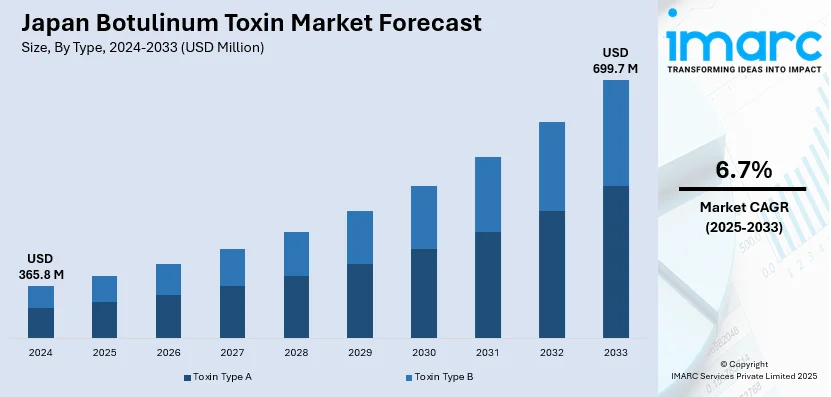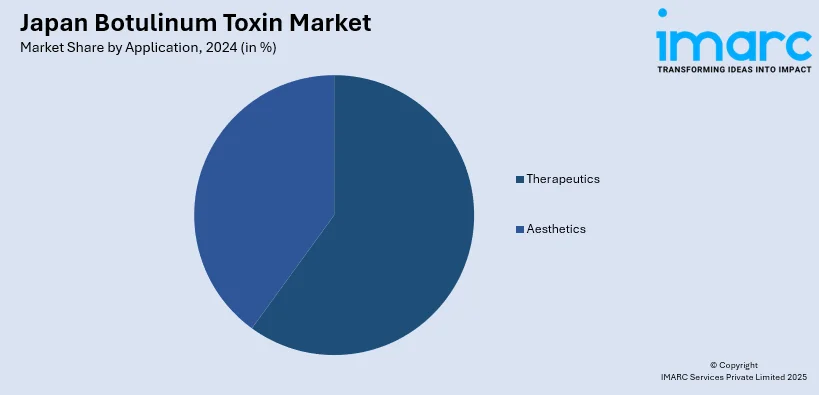
Japan Botulinum Toxin Market Size, Share, Trends and Forecast by Type, Application, End User, and Region, 2025-2033
Japan Botulinum Toxin Market Overview:
The Japan botulinum toxin market size reached USD 365.8 Million in 2024. Looking forward, IMARC Group expects the market to reach USD 699.7 Million by 2033, exhibiting a growth rate (CAGR) of 6.7% during 2025-2033. Rising aesthetic procedures, aging population, growing demand for anti-aging treatments, expanding applications in therapeutics (like chronic migraine and muscle disorders), increased awareness, technological advancements in formulations, and wider acceptance of minimally invasive cosmetic and medical procedures are some of the factors propelling the growth of the market.
|
Report Attribute
|
Key Statistics
|
|---|---|
|
Base Year
|
2024 |
|
Forecast Years
|
2025-2033
|
|
Historical Years
|
2019-2024
|
| Market Size in 2024 | USD 365.8 Million |
| Market Forecast in 2033 | USD 699.7 Million |
| Market Growth Rate 2025-2033 | 6.7% |
Japan Botulinum Toxin Market Trends:
Expanding Clinical Pipeline to Strengthen Market Footprint
The Japan botulinum toxin market is witnessing increased activity from global players looking to establish or broaden their footprint. There is a noticeable focus on clinical trial investments targeting local regulatory pathways, signaling long-term strategic positioning. Recent developments involve formal trial partnerships for innovative formulations, particularly liquid variants, indicating a shift toward differentiated delivery formats. These moves are aligned with the goal of achieving local approvals within the next few years, reflecting a competitive push to secure a share in a market known for stringent regulatory standards and high-quality benchmarks. Such initiatives are not limited to short-term goals but indicate broader ambitions to embed operations deeper into Japan’s aesthetic and therapeutic segments, leveraging local validation to unlock future commercial access. For example, in October 2024, Medytox entered into a clinical trial consignment agreement for its botulinum toxin product, MT10109L, in Japan. The company aims to secure formal authorization by 2028, marking a strategic move to expand its presence in the Japanese market.

Strengthening Aesthetic Infrastructure through Local Ventures
In Japan, the botulinum toxin market is seeing greater focus on distribution expansion and localized business development. Companies are setting up dedicated ventures to improve access to aesthetic medical devices, including botulinum toxin solutions. These initiatives aim to streamline product availability, tailor offerings to local demand, and build stronger ties with clinics and practitioners. By establishing a direct presence, firms can better navigate domestic regulations, respond to evolving preferences in cosmetic procedures, and offer integrated platforms combining injectables with device-based treatments. This approach also supports faster adoption of combination therapies, where botulinum toxin is used alongside energy-based devices. The emphasis on domestic operations underscores a broader shift toward long-term investments in Japan’s growing aesthetic sector, with a focus on service quality and brand positioning. For instance, in November 2023, Alma, a subsidiary of Sisram Medical, established a new venture in Japan to strengthen its presence in the Asia-Pacific region. This initiative aims to enhance the distribution of its aesthetic medical devices, including those related to botulinum toxin treatments.
Japan Botulinum Toxin Market Segmentation:
IMARC Group provides an analysis of the key trends in each segment of the market, along with forecasts at the region/country level for 2025-2033. Our report has categorized the market based on type, application, and end user.
Type Insights:
- Toxin Type A
- Toxin Type B
The report has provided a detailed breakup and analysis of the market based on the type. This includes toxin type A and toxin type B.
Application Insights:

- Therapeutics
- Aesthetics
A detailed breakup and analysis of the market based on the application have also been provided in the report. This includes therapeutics and aesthetics.
End User Insights:
- Hospitals and Clinics
- Dermatology Clinics
- Spas and Cosmetic Centers
A detailed breakup and analysis of the market based on the end user have also been provided in the report. This includes hospitals and clinics, dermatology clinics, and spas and cosmetic centers.
Regional Insights:
- Kanto Region
- Kansai/Kinki Region
- Central/Chubu Region
- Kyushu-Okinawa Region
- Tohoku Region
- Chugoku Region
- Hokkaido Region
- Shikoku Region
The report has also provided a comprehensive analysis of all the major regional markets, which include Kanto region, Kansai/Kinki region, Central/Chubu region, Kyushu-Okinawa region, Tohoku region, Chugoku region, Hokkaido region, and Shikoku region.
Competitive Landscape:
The market research report has also provided a comprehensive analysis of the competitive landscape. Competitive analysis such as market structure, key player positioning, top winning strategies, competitive dashboard, and company evaluation quadrant has been covered in the report. Also, detailed profiles of all major companies have been provided.
Japan Botulinum Toxin Market News:
- In March 2025, Sisram Medical reported its first-half 2024 financial results, noting a substantial increase in revenue from its botulinum toxin products. The company attributed this growth to successful market penetration strategies in Japan and other Asia-Pacific countries.
Japan Botulinum Toxin Market Report Coverage:
| Report Features | Details |
|---|---|
| Base Year of the Analysis | 2024 |
| Historical Period | 2019-2024 |
| Forecast Period | 2025-2033 |
| Units | Million USD |
| Scope of the Report | Exploration of Historical Trends and Market Outlook, Industry Catalysts and Challenges, Segment-Wise Historical and Future Market Assessment:
|
| Types Covered | Toxin Type A, Toxin Type B |
| Applications Covered | Therapeutics, Aesthetics |
| End Users Covered | Hospitals and Clinics, Dermatology Clinics, Spas and Cosmetic Centers |
| Regions Covered | Kanto Region, Kansai/Kinki Region, Central/Chubu Region, Kyushu-Okinawa Region, Tohoku Region, Chugoku Region, Hokkaido Region, Shikoku Region |
| Customization Scope | 10% Free Customization |
| Post-Sale Analyst Support | 10-12 Weeks |
| Delivery Format | PDF and Excel through Email (We can also provide the editable version of the report in PPT/Word format on special request) |
Key Questions Answered in This Report:
- How has the Japan botulinum toxin market performed so far and how will it perform in the coming years?
- What is the breakup of the Japan botulinum toxin market on the basis of type?
- What is the breakup of the Japan botulinum toxin market on the basis of application?
- What is the breakup of the Japan botulinum toxin market on the basis of end user?
- What are the various stages in the value chain of the Japan botulinum toxin market?
- What are the key driving factors and challenges in the Japan botulinum toxin market?
- What is the structure of the Japan botulinum toxin market and who are the key players?
- What is the degree of competition in the Japan botulinum toxin market?
Key Benefits for Stakeholders:
- IMARC’s industry report offers a comprehensive quantitative analysis of various market segments, historical and current market trends, market forecasts, and dynamics of the Japan botulinum toxin market from 2019-2033.
- The research report provides the latest information on the market drivers, challenges, and opportunities in the Japan botulinum toxin market.
- Porter's five forces analysis assist stakeholders in assessing the impact of new entrants, competitive rivalry, supplier power, buyer power, and the threat of substitution. It helps stakeholders to analyze the level of competition within the Japan botulinum toxin industry and its attractiveness.
- Competitive landscape allows stakeholders to understand their competitive environment and provides an insight into the current positions of key players in the market.
Need more help?
- Speak to our experienced analysts for insights on the current market scenarios.
- Include additional segments and countries to customize the report as per your requirement.
- Gain an unparalleled competitive advantage in your domain by understanding how to utilize the report and positively impacting your operations and revenue.
- For further assistance, please connect with our analysts.
 Request Customization
Request Customization
 Speak to an Analyst
Speak to an Analyst
 Request Brochure
Request Brochure
 Inquire Before Buying
Inquire Before Buying




.webp)




.webp)












